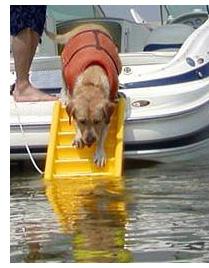
Many a dog and dog owner are inseparable pals and with the pooch population in the United States at 75 million and growing, it should come as no surprise that it isn’t just Labrador Retrievers and other time-honored water dogs climbing into boats these days. Dogs can be seen taking in the sun and spray on all manner of sail and powerboats, and adapting just fine.
But pet owners shouldn’t assume that because dogs can swim that their particular dog is an adequate swimmer, or that it has the good sense not to chase that sea gull over the side. Dogs are “hard-wired” to chase and swimming ability varies from breed to breed. Many with low body fat, like Greyhounds, may have trouble staying afloat. Breeds with short legs and long bodies can swim but may tire quickly. Overboard, a dog can become disoriented and suffer the same hazards from coldwater immersion as humans.

A trusted friend in trouble can pose a danger for the owner too. Every year, the U.S. Coast Guard logs reports of dog owners who drown trying to rescue their pet from deep water. Also, the bigger the dog, the harder it is to haul them back into the boat, and a large dog, wet and thrashing, can easily pull a would-be rescuer overboard.
So before bringing the family pet along on a boating excursion, ask yourself this: How well does the dog swim? How cold is the water? How long will it take to turn the boat around to retrieve the dog if it falls overboard? Will the dog be easy to spot in the water? How will it get back into the boat?
Fortunately for dog owners, the same technological advancements that have resulted in specialized life jackets for every on-the-water human activity now enable boaters to extend a similar measure of safety to their pets.
Life jackets for dogs were first introduced in the mid-1990s and have become highly popular on the nation’s inland and coastal waterways. Found in pet shops, marine supply stores, and on the Internet, they come in a variety of colors and styles, including float coats and auto-inflatables.
For larger dogs, consider installing a pet ramp or stair on the back of the boat for easy access. Similar to those used to get older dogs into trucks and SUVs, these devices allow the dog to climb aboard safely while saving the owner’s back.
Small dogs pose less of a problem. Most pet life jackets have a handle on the back that helps in hauling smaller dogs from the water. With very small dogs it can also come in handy for transferring them between the boat and the dock. Be sure to have a backup plan, however. Even a fishing net, attached with a line to the boat, can be a useful tool in getting a small dog back aboard quickly.
Of course, the best course of action is to make sure your dog only goes in the water when permitted to do so. When the boat is underway, keep the dog safely restrained. A leash attached to a collar can present a choking hazard if a dog bolts overboard, but a dog life jacket, with a D-ring on back for attaching to a leash, can do dual-duty as a harness, providing a reliable restraint for an excitable pet.
When you think about it, dogs really are like family. We pamper them. We take them wherever we go. We talk to them (and swear they understand what we say). But we can’t expect them to recognize every dangerous situation.
Fortunately, for the nation’s approximately 13 million recreational boat owners, there are sensible solutions for those seeking peace of mind along with furry companionship. The right equipment, along with a little common sense, can ensure a safer outing for both of you.
Fitting your Dog for a Life Jacket
If you’re considering a life jacket for your boat-happy dog, think about comfort and purpose. A foam-filled float coat may be more appropriate for dogs going in and out of the water. For dogs expected to stay in the boat, an auto-inflatable is cool, lightweight, and provides emergency support.
In the boat and in the water, a proper fit is important:
- Check the width of the straps and where they cross under the dog’s body. The straps should not interfere with the dog’s ability to sit or lie down comfortably.
- Be sure the life jacket fits snugly enough that the dog won’t slip out of it when wet or being pulled into the boat.
- Choose a bright color to make the dog easier to spot in the water.
- Conduct a “float test,” just as you would with a life jacket for a person. Try it out on the dog in shallow water and have a harness and leash on as backup.
- Pet life jackets, unlike those for people, are designed to float the animal in a horizontal position. The jacket should support the dog in the water while allowing it to swim freely.
The U.S. Coast Guard is asking all boat owners and operators to help reduce fatalities, injuries, property damage, and associated healthcare costs related to recreational boating accidents by taking personal responsibility for their own safety and the safety of their passengers. Essential steps include: wearing a life jacket at all times and requiring passengers to do the same; never boating under the influence (BUI); successfully completing a boating safety course; and getting a Vessel Safety Check (VSC) annually from local U.S. Coast Guard Auxiliary, United States Power Squadrons(r), or your state boating agency’s Vessel Examiners. The U.S. Coast Guard reminds all boaters to “Boat Responsibly!” For more tips on boating safety, visit www.uscgboating.org.








